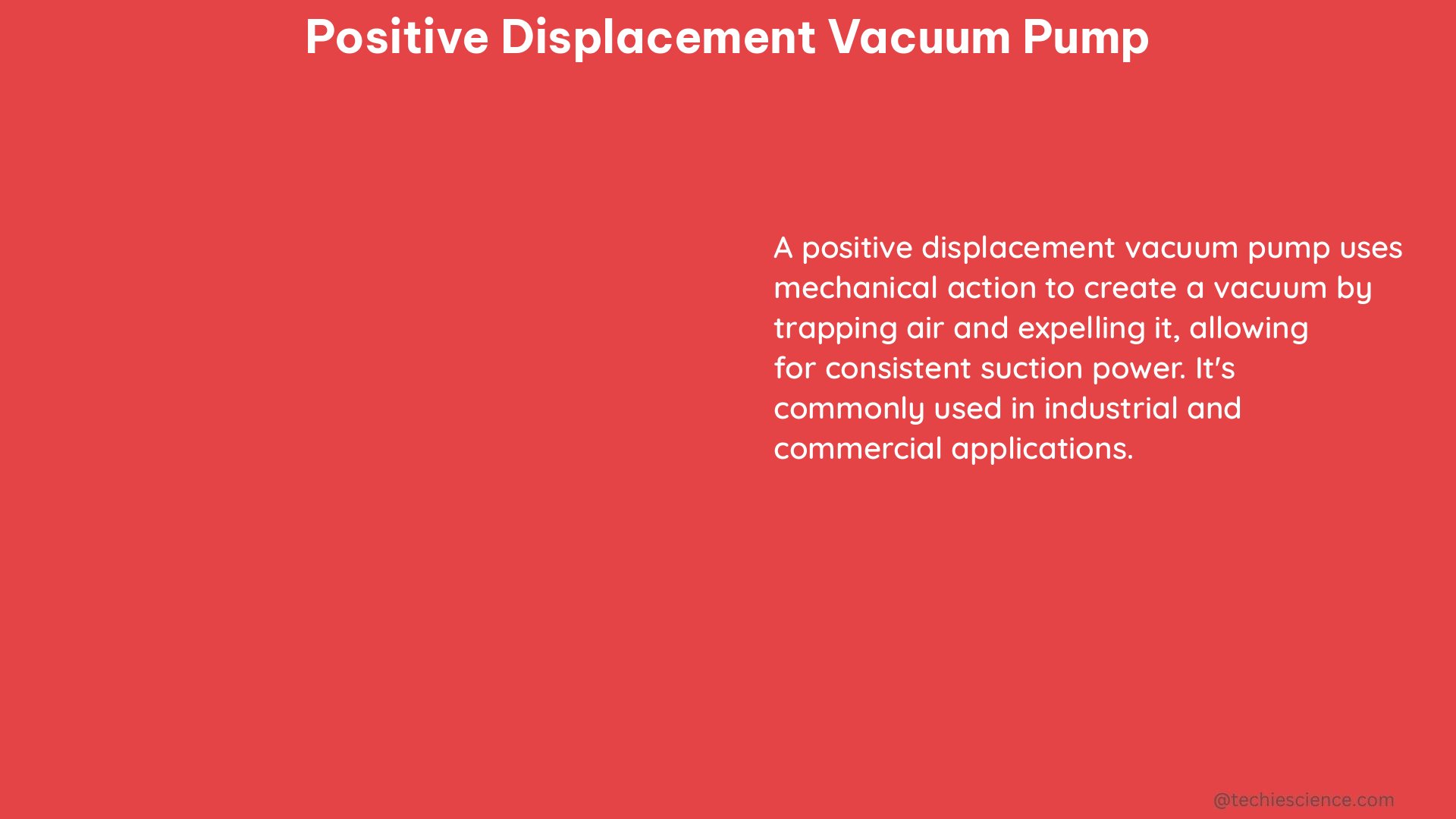Positive displacement vacuum pumps are a versatile and efficient type of pump that are widely used in various industries, from manufacturing to scientific research. These pumps work by repeatedly enclosing a fixed volume of gas or fluid and mechanically moving it through the system, making them capable of handling higher viscosity fluids and operating at high pressures and relatively low flow rates more efficiently than centrifugal pumps.
Types of Positive Displacement Vacuum Pumps
The two main types of positive displacement vacuum pumps are reciprocating and rotary:
- Reciprocating Pumps:
- Use pistons, diaphragms, or plungers to move fluid
- Examples include piston pumps, diaphragm pumps, and plunger pumps
- Capable of generating high vacuum levels, typically down to 10^-3 Torr (0.133 Pa)
-
Can handle higher viscosity fluids and abrasive solids
-
Rotary Pumps:
- Use gears, screws, lobes, or vanes to move fluid
- Examples include rotary vane pumps, screw pumps, and Roots pumps
- Capable of generating moderate vacuum levels, typically down to 10^-2 Torr (1.33 Pa)
- Suitable for continuous operation and higher flow rates
Efficiency and Fluid Handling Characteristics

The efficiency of positive displacement vacuum pumps increases with increasing fluid viscosity. This is because the seal between the rotating elements and the pump housing is more effective with higher viscosity fluids, reducing leakage and improving overall efficiency.
However, positive displacement pumps are less capable of handling low viscosity fluids compared to centrifugal pumps. This is due to the reduced seal between the rotating elements and the pump housing, which can lead to increased leakage and reduced performance.
Pulsation and Vibration
One of the key challenges with positive displacement vacuum pumps is the pulsing discharge they can produce. This pulsing can cause noise and vibration in the pipe system, as well as cavitation problems that can ultimately lead to damage or failure of the pump and associated components.
To mitigate these issues, positive displacement vacuum pump systems often incorporate multiple pump cylinders and pulsation dampeners. However, this requires careful system design to ensure optimal performance and reliability.
Reciprocating Pump Challenges
The back-and-forth motion of a reciprocating positive displacement vacuum pump can also be a source of vibration and noise. This requires the use of strong foundations and pressure relief systems in case of a blockage or other unexpected event.
Additionally, feeds containing a high level of abrasive solids can cause excessive wear on the components of all types of positive displacement pumps, particularly valves and seals. This may necessitate the use of more robust pump designs, such as lobe, screw, or diaphragm pumps, to ensure reliable and long-lasting operation.
Global Positive Displacement Vacuum Pump Market
The global Positive Displacement Vacuum Pump market is segmented by type, application, and region. Some of the key product types include:
- Diaphragm pumps
- Scroll pumps
- Rotary vane pumps
- Roots pumps
The actual lowest pressure achieved by a positive displacement vacuum pump is known as its ultimate pressure, which can vary depending on the specific pump design and operating conditions.
DIY Positive Displacement Vacuum Pump
For DIY enthusiasts, a positive displacement vacuum pump can be built using a diaphragm pump, which is a basic type of positive displacement pump that is simple in design, reliable, and relatively low-cost. The pumping cycle of a diaphragm pump consists of two phases:
- Gas Capture Phase: The diaphragm stretches, increasing the volume within the pump chamber and causing the inlet valve to open, allowing gas to flow into the expanded space.
- Compression Phase: The diaphragm is pushed up, decreasing the volume of the chamber and compressing the trapped gas.
By understanding the principles and characteristics of positive displacement vacuum pumps, DIY enthusiasts can design and build their own custom vacuum systems for a variety of applications, from scientific experiments to industrial processes.
References:
– Positive Displacement Pumps: Useful Information
– Global Positive Displacement Vacuum Pump Market Report
– Introduction to Vacuum Technology: Rough Vacuum Regime

The lambdageeks.com Core SME Team is a group of experienced subject matter experts from diverse scientific and technical fields including Physics, Chemistry, Technology,Electronics & Electrical Engineering, Automotive, Mechanical Engineering. Our team collaborates to create high-quality, well-researched articles on a wide range of science and technology topics for the lambdageeks.com website.
All Our Senior SME are having more than 7 Years of experience in the respective fields . They are either Working Industry Professionals or assocaited With different Universities. Refer Our Authors Page to get to know About our Core SMEs.